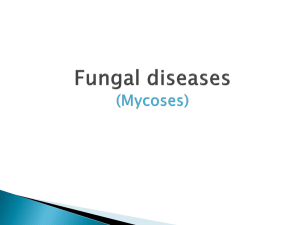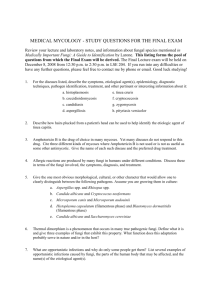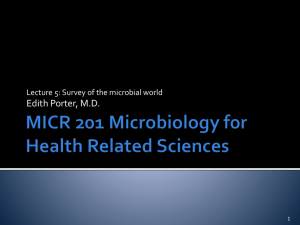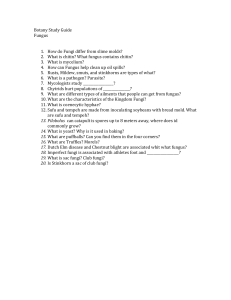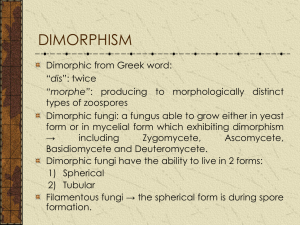question bank
advertisement
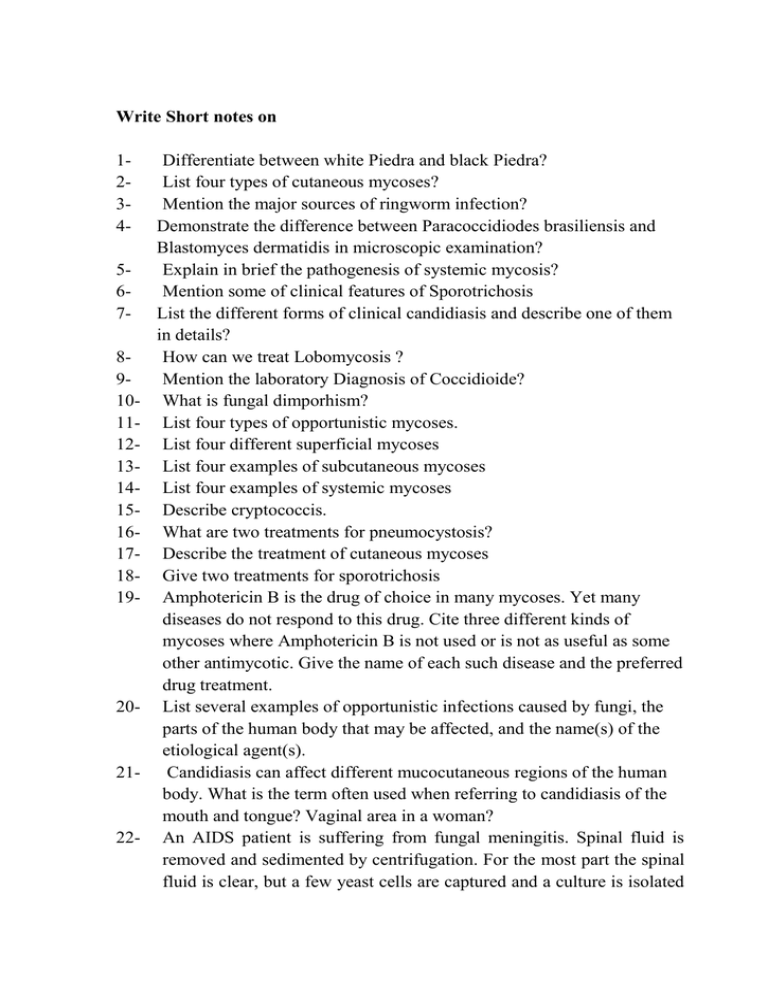
Write Short notes on 12345678910111213141516171819- 20- 21- 22- Differentiate between white Piedra and black Piedra? List four types of cutaneous mycoses? Mention the major sources of ringworm infection? Demonstrate the difference between Paracoccidiodes brasiliensis and Blastomyces dermatidis in microscopic examination? Explain in brief the pathogenesis of systemic mycosis? Mention some of clinical features of Sporotrichosis List the different forms of clinical candidiasis and describe one of them in details? How can we treat Lobomycosis ? Mention the laboratory Diagnosis of Coccidioide? What is fungal dimporhism? List four types of opportunistic mycoses. List four different superficial mycoses List four examples of subcutaneous mycoses List four examples of systemic mycoses Describe cryptococcis. What are two treatments for pneumocystosis? Describe the treatment of cutaneous mycoses Give two treatments for sporotrichosis Amphotericin B is the drug of choice in many mycoses. Yet many diseases do not respond to this drug. Cite three different kinds of mycoses where Amphotericin B is not used or is not as useful as some other antimycotic. Give the name of each such disease and the preferred drug treatment. List several examples of opportunistic infections caused by fungi, the parts of the human body that may be affected, and the name(s) of the etiological agent(s). Candidiasis can affect different mucocutaneous regions of the human body. What is the term often used when referring to candidiasis of the mouth and tongue? Vaginal area in a woman? An AIDS patient is suffering from fungal meningitis. Spinal fluid is removed and sedimented by centrifugation. For the most part the spinal fluid is clear, but a few yeast cells are captured and a culture is isolated and grown from these cells. You are given this culture and asked to identify it. You suspend some yeast cells in India ink and examine this on a slide. Microscopic examination indicates the presence of a capsule around the yeast cell. Based on these test results, what is the specie that this culture likely represents? What other feature(s) might you look for to help confirm your identification to a single species? 23- Give a definition or explanation of the following words or terms, and give one example of a fungus associated with each of these. a. zygomycosis b.Candididsis c. Thermal dimorphism d. Spherule e. Pulmonary infection f. Nasal polyps g. Meningitis h. Vaginitis 24- Enumerate dimorphic fungi and describe their pathogenesis. 25- Name two fungi causing occulomycosis. 26- Enumerate four dermatophytes. 27- List four organisms causing Mycetoma. Choose the correct answer 1- The causative agent of cryptococcal meningoencephalitis belongs to the group of organsims known as A: bacteria B: Archea C:protozoans D: yeasts E: flatworms 2- The causative agent of cryptococcal meningoencephalitis is A) Enterobacter meningitis B) Cryptococcus neoformans C) Balantidium coli 3- 4- 5- 6- 7- D) Entamaeba neoformans E: Cyrobacillus neoformans In the pathology of cryptococcal meningoencephalitis, the infection is established first in A) the lung B) the skin C) the brain D) the oral cavity E) the gut Cryptococcal meningoencephalitis is frequently associated with A) mushrooms B) pigeon droppings C) dairies D) hospital neonatal wards E) blunt trauma Although fungal infections of wounds are unusal in North America, which of the following infections occasionally causes small epidemics A) Sporotrichosis B) Tineasis C) Candiasis D) Trichomoniasis E) Tetanus Frequently sprotrichosis is caused when the infectious agent is introduced into wounds by A) lotions B) rusty nails C) food preparation D) artificial nails E) thorns In the United States, most cases of sporotrichosis occur in A) Colorado B) San Joaquin C) Mississippi and Missouri river valleys D) Oregon and Montana E) indian reservations in Oklahoma 8- A substance known to be a potential source of Sporothrix schenkii is A) cow manure B) evergreen seedlings C) mushrooms D) spaghnum moss E) horse manure 9- Thrush and vaginitis are caused by A) Herpesvirus. B) Chlamydia trachomatis. C) Candida albicans. D) Staphylococcus aureus. E) Streptococcus pyogenes. 10- A 45-year-old male has pus-filled vesicles distributed over his back in the upper right quadrant, over his right shoulder, and upper right quadrant of his chest. His symptoms are most likely due to A) Candida albicans. B) Herpes simplex virus. C) Staphylococcus aureus. D) Streptococcus pyogenes. E) Varicella-zoster virus. 11- Assume that your lab partner swabs the side of his face and used the swab to inoculate a nutrient agar plate. The next day, he performs a Gram stain on the colonies. They are Gram-positive cocci. You advise him that he should next look for A) An acid-fast reaction. B) A coagulase reaction. C) Conidiospores. D) Pseudohyphae. E) Pseudopods. 12- The organism that is said to be responsible for tinea versicolr is A) Tinea spp B) Melassezia spp C) Mucor D) Trichophyton E) Epidermophyton 13- The skin invading molds belong mainly to the genera Trichophyton, Microsporum and Epidermophyton are collectively called A) Candida B) dermatophytes C) ringworm D) dermatomycoses E) althelete's foot 14- Generally the dematophytes are unable to grow in living tissue but multiply in structures which contain A) pectin B) collagen C) keratin D) fibrin E) calcium 15- Fungi of the lower respiratory tract are A) Candida B) Epidermophyton C) normally absent D) Tinea spp E) Trichophyton 16- Two widespread North American lung mycoses are A) candidiasis and coccidiomycosis B) candidiasis and aspergillosis C) Aspergillosis and blastomycosis D) histoplasmosis and blastomycosis E) coccidiomycosis and histoplasmosis 17- The causative agent of coccidiomycosis is Coccidioides immitis. it can be described as a(n) A) yeast like fungus found in root nodules B) a dimorphic fungus living in the soil C) endospore found in the sol D) obligate parasite E) speruloplasm 18- The "Tissue phase" of Coccidiodes immitis can be identified in sputum or pus as a thick-walled, non budding _______ A) spherule B) spore C) hypha D) mycelium E) endospore 19- Transmission of coccidioidomycosis occurs by A) swelling and coughing up of spherules B) ingestion of contamination food C) inhalation of spores D) a puncture wound E) aerosol droplets of the infective agent 20- The cause of histoplasmosis is found most frequently in soil contaminated by A) cow manure B) sewage C) horse manure D) bat or bird droppings E) moldy hay 21- The causative agent of histoplasmosis is the dimorphic fungus A) Mycobacterium B) Coccidioides immitis C) Aspergillis D) Candida E) Histoplasma capsulatum 22A 35-year-old female has a red, raised rash on the inside of her thighs. Gram-stained skin scrapings show large budding cells with pseudohyphae. The infection is caused by A) Candida albicans. B) Herpes simplex virus. C) Staphylococcus aureus. D) Streptococcus pyogenes. E) Varicella-zoster virus. 23The organism that is said to be responsible for Tinea versicolor is A) Tinea spp B) Melassezia furfur B) Mucor D) Trichophyton E) Epidermophyton 24The skin invading molds belong mainly to the genera Trichophyton, 25Microsporum and Epidermophyton are collectively called A) Candida B) Dermatophytes B) Ringworm D) Superficial mycoses E) Athletes foot 26Generally the dermatophytes are unable to grow in living tissue but multiply in structure which contain A) Pectin B) Collagen B) Keratin D) fibrin E) calcium 27The surface layer of the skin is the .The deeper layer of skin cells is the A) Epidermis, dermis B) Cutaneous, keratin B) Keratin, dermis D) dermis, cutaneous E) dermis, epidermis 28Which of the following is not a cause of ringworm? A) Microsporum B) Trichophyton C) Candida albicans D) Epidermophyton E) None of the above 30- A 35-year-old female has brownish maculae on palms, fingers, face. The infection is caused by A) Candida albicans. B) Piedraia hortae B) Melassezia furfur D) Trichophyton. E) Exophiala werneckii. 31- Fungi that produce sexual resting spores by the union of two gametes a) Ascomycota b) Deutromycota c) Basidiomycota d) Zycomycota 32- Frequently Sporotrichosis is caused when the infectious agent is introduced into wounds by A) Lotions B) Rusty nails C) Food preparation D) Thorns E) Artificial nails 33- A substance known to be a source of Rhinosporidium seeberii is A) Cow manure B) Plant C) Soil D) Ponds E) None of the above 35- Which of the following can be treated with topical chemotherapeutic agents? A) Eumycetoma B) Sporotrichosis C) Lobomycosis 36- A fungus does not have a) Chlorophyll b) Cell wall c) Multiple cells d) Nucleus 37- A multinucleate mass of protoplasm, without a cell wall is called a) Hyphae b) Plasmodium c) Anthridium d) Oogonium 38- The only pathogenic yeast in medical mycology is a) Cryptococcus neoformans b) Candida albicans c) Histoplasma capsulatum d) SchizoSaccharomyces octosporus D) Chromoplastomycosis E) None of the above 39- The causative agent of Lobomycosis is the dimorphic fungus A) Acremonium B) Pseudallescheria boydii C) Phialophora D) Lacazia loboi E) Fonsecaea Species Put (√) or (X) in the front of the following (answer five only): 1- A fungus does not have chlorophyll. 2- A multinucleate mass of protoplasm, without a cell wall is called Hyphae. 3- Fungi that produce sexual resting spores by the union of two gametes are classified as Ascomycota. 4- Cell wall of true fungi is composed of Ergosterol. 5- Topical salicylic acid can be used to treat keratomycosis 6- Trichosporon is said to be responsible for white Piedra. 7- Fungi are microorganisms that are prokaryotic. 8- Most fungi are parasitic living on dead organisms. 9- Some fungi can be used as a food. 10- Zygomycota produce zoospores inside sporangium. 11- Deuteromycota is believed to lack a method of asexual reproduction. 12- The organism that is said to be responsible for Mycetoma is Pseudoallescheria boydii. 13- In the pathology of Verrucous dermatitis, the infection is established first in the skin by traumatic implantation. 14- The causative agent of Phaeohyphomycosis belongs to the group of organsims known as dematiaceous fungi. 15- Rhinosporidium seeberi, the causal organism of Rhinosporidiosis cannot be cultured. 16- Cryosurgery can be used to treat Lobomycosis. 17- Systemic mycoses is called Epidemic mycoses. 18- Candidiasis is considered a nosocomial disease. 19- The causative agent of systemic mycosis belongs to the group of organsims known as dimorphic fungi. 20- Cutaneous candidiasis means the infection of mouth with Candida albicans. 21- Blastomyces dermatidis is isolated from birds & bats excreta. 22- Coccidiodes immitis is endemic in Southwestern USA. 23- Chlamydospores production is characteristic for Candida species. 24- Exophiala jeanselmei is a causative agent of Mycetoma 25- Cryptococcosis is one of the fungal mycoses caused by Candida species. 26- Cryptococcus neoformans is capsulated fungal cell. Fill the spaces using the following words: (Infection –opportunistic - Germ tube - Radical Surgery - Histoplasma – Chromagar- Sporotrichosis- Rhinosporidiosis- ChromoblastomycosisCandidiasis- Aspergillosis- ) 1- In laboratory diagnosis of candidiasis, ………………..medium may be used to differentiate Candida species. 2- Fungi associated with fungal mycetoma are ....................... 3- Candidiasis is a primary or secondary mycotic ……………..caused by members of the genus Candida. 4- …………………………test is the most diagnostic laboratory test used to identify Candida albicans using the serum. 5- ....................................... can be used for treatment of Rhinosporidiosis . 6- The organism that is said to be responsible for histoplasmosis is ………........……. 7- ............................is caused by Sporothrix schenckii, a dimorphic fungus. 8- .............................is characterized by the development of friable polyps in the nose, mouth or eye. 9- Warty cutaneous nodules which resembles flouts of cauliflower is called…………………….. 10- .............................is defined as primary or secondary mycotic infection caused by members of the genus Candida. 11- ...........................is defined as Systemic infection in immunocompromised as well as immunocompetent individuals. Complete the following table Agent Blastomyces dermatitidis Infection Dissemination Coccidioides immitis Paracoccidioidoes brasiliensis Histoplasma capsulatum Genus Macroconidia Microconidia Microsporum ………………… …………………. …………………. ………………….. Epidermophyton ………………… …………………. ………………… …………………. Trichophyton ………………… …………………. ………………… …………………. Choose from column A what suits it from column A Blastomyces dermatidis is isolated 1from Histoplasma lesions may heal with 2- B as a spherule in tissue ….. 3- Serological diagnosis blastomycosis is not reliable of 3- calcification of granuloma ….. 4- Coccidioides immitis is a dimorphic fungus that exists as 4- because these antigens are Poorly defined. ….. 5 Thrush 5- as a yeast in tissue ….. 6 Balanitis 6- birds & bats excreta ….. 7 ….. 8 ….. 9 Farmer’s lung disease fungi are living on dead organisms fungi are living on plants or animals Onychomycosis Vaginitis Endophthalmitis Aspergilloma Mucormycosis 7 8 9 Candidiasis of the penis Saprophytic fungi Parasitic fungi 10 11 12 13 14 ….. 15 Mycetism 15 ….. 16 Mycotoxicosis 16 ….. 17 Another name for Mycetoma is 17 Oral candidiasis Candidiasis of the nails Vaginal candidiasis Candidiasis of the eye Compact mass of fungal mycelia surrounded by dense fibrous walls Invasive disease caused by lower fungi – Zygomycetes Fungus, which is eaten, itself causes toxic effects. Food contaminated by fungal toxins ….. 1….. 2- ….. ….. ….. ….. ….. 10 11 12 13 14 the soil and rotten wood ….. 18 ….. 19 20 Cell wall of true fungi is composed of Another name for histoplasmosis is 18 Maduromycosis 19 Chitin 20 Spelunkers disease
